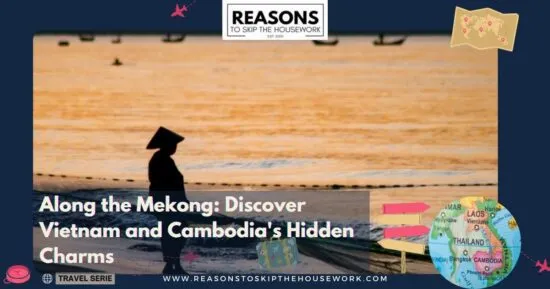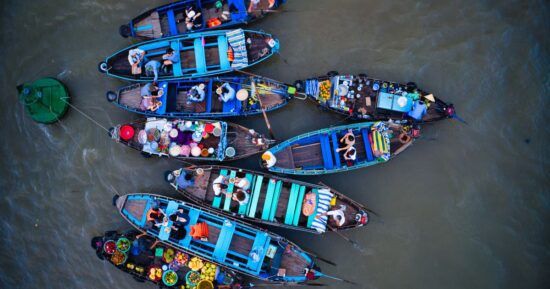Southeast Asia’s lifeline, the Mekong River, flows through numerous civilizations and landscapes. It provides travelers with an immersion into out-of-the-way places and culture in Vietnam and Cambodia, revealing a mosaic of hidden gems.

Contents
Luxury Cruising
Mekong River cruises blend deep cultural roots, historic scenery, and contemporary luxury. Beautiful ships provide expansive vistas from every deck and stateroom as they cruise over placid waters.
The onboard luxuries include gourmet meals, wellness services, and individualized attention designed for deep exploration. The serene voyage creates a striking contrast to the lively vitality of riverbank towns. Traditions, marketplaces, and architecture frequently inaccessible by plane or road are revealed at each visit.
A new chapter in the Mekong’s history is revealed at each mooring location. Travelers in Vietnam explore winding waterways dotted with fruit farms and palm trees. Rare cultural insights may be gained in Cambodia by touring temples, villages, and farms.
While monks sing in neighboring golden pagodas, children wave from the banks of the river. Going on a mekong luxury river cruise bonds visitors with real living outside the usual tourist route, bridging worlds.
Vietnam’s Mekong Delta
Through many communities that provide a distinctive cultural experience, the Mekong Delta displays its allure. The tour is filled with vibrant images and intriguing stories in places like sacred mountains and floating marketplaces.
Cai Rang Floating Market: A Vibrant Waterborne Bazaar
In Can Tho, the Cai Rang Floating Market buzzes with activity as boats laden with fresh produce and goods navigate the waterways. Early mornings are ideal for witnessing this dynamic exchange, where vendors sell fruits, vegetables, and local delicacies directly from their boats.

Sa Dec: Floral Magnificence and Colonial Echoes
Discover the ancient monuments and colorful flower greenhouses of Sa Dec, a charming town with French colonial architecture. Relative to Marguerite Duras’ book “The Lover,” the Huynh Thuy Le Ancient House is a reminder of the town’s past.
Tan Chau: Silk Weaving and Cultural Fusion
Tan Chau, close to the Cambodian border, is well known for its traditional silk weaving that uses the mac nua fruit as a natural color. Visitors may witness the peaceful blending of Khmer, Chinese, and Vietnamese cultures while watching artists at work.
Bảy Núi: The Seven Mountains of Spiritual Significance
The Bảy Núi region, also known as Thất Sơn, comprises seven sacred mountains revered in Vietnamese Buddhism. Núi Cấm, the highest peak, offers panoramic views and is a pilgrimage site for devotees seeking spiritual solace.
Culinary Delights and Cultural Experiences
The Mekong Delta’s cuisine reflects its cultural diversity, featuring dishes like hu tieu (noodle soup) and banh xeo (savory pancakes). Fresh herbs, seafood, and tropical fruits are staples in local meals.
Cambodian dishes like amok (steamed fish curry) and bai sach chrouk (grilled pork with rice) highlight the nation’s culinary heritage. Markets and street stalls offer authentic flavors for adventurous palates.
Festivals and Natural Wonders Along the Mekong
The Mekong’s vibrant rhythm comes alive through its festivals and natural treasures. From lively celebrations to protected wildlife sanctuaries, the river nurtures culture and biodiversity alike.
Bon Om Touk
During Bon Om Touk, which is observed in November, the flow of the Tonlé Sap River is reversed. Dragon boat racing, illuminated floats, and traditional foods like amok—a treat made from flattened rice—are all part of the festivities.
Kulen Promtep Wildlife Sanctuary
Diverse habitats and endangered species, including the gigantic ibis, are safeguarded in the Kulen Promtep Wildlife Sanctuary in northern Cambodia. The refuge provides chances to see wildlife and engage in ecotourism.
Tonlé Sap Lake
Tonlé Sap, the largest freshwater lake in Southeast Asia, is home to floating communities and a wealth of species. Communities here adapt to seasonal changes to maintain a symbiotic relationship with the lake environment.
Cambodia’s Mekong
Each destination along the river reveals a different layer of the nation’s enduring spirit and rich traditions.
Angkor Ban
Angkor Ban, one of the few villages untouched by the Khmer Rouge, showcases traditional wooden stilt houses and a way of life that has remained unchanged for generations. Strolling through its lanes offers a glimpse into Cambodia’s enduring rural heritagе.
Koh Dach
Koh Dach, or Silk Island, is a haven for traditional silk weaving. Artisans here meticulously craft the iconic Cambodian krama scarves, preserving techniques passed down through generations.
Koh Chen
In Koh Chen, skilled silversmiths create intricate silverware, from ceremonial bowls to ornate jewelry. Visitors can observe the meticulous crafting process and purchase unique souvenirs directly from the artisans.
Phnom Penh
Cambodia’s capital, Phnom Penh, juxtaposes its vibrant present with a poignant past. The Royal Palace and Silver Pagoda reflect regal grandeur, while the Tuol Sleng Genocide Museum and Choeung Ek Killing Fields are solemn reminders of the country’s turbulent history.
Oudong
Oudong, once Cambodia’s royal capital, is dotted with stupas and temples atop its twin hills. The site offers panoramic views and insights into the nation’s spiritual and political legacy.
Sustainable Travel and River Conservation
Modern Mekong cruises embrace eco-conscious practices to protect this vital waterway. Many operators reduce waste, avoid single-use plastics, and support river cleanup efforts.
Local partnerships ensure tourism benefits surrounding communities through fair trade and employment. By traveling responsibly, cruise passengers contribute to preserving both culture and ecology. The river remains not just a route, but a shared responsibility.
